Krishnajoo Razdan
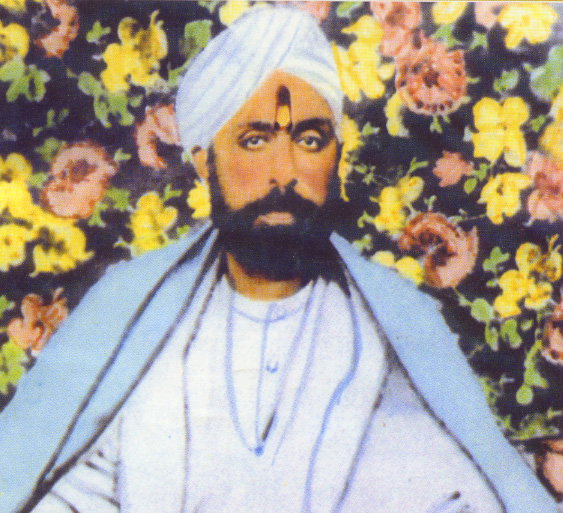 Krishna Joo Razdan
Krishna Joo RazdanFeatured Collections
Razdan Sahib's Puranic Picture Gallery
Author: ??? (Please let us know)
Krishna Joo Razdan's "Maharaja Mahadevun Che Chhui Saal" is a superb Puranic picture gallery. In this devotional lyric cosmos is the studio-cum-exhibition hall, Lord Vishnu is the model and Krishna Joo Razdan, incognite as Narada, is the inspired literary painter. The bard's devout imagination, telescoping Lord Vishnu's variegated associated exploits, objectified them on literary canvas. Like impressionistic painters, Krishna Joo paints diverse fleeting associations conjured up by his unique model. Each quatrain in the lyric is a picture-frame exhibiting two or more pictures. Here the model remains unaltered but there are constant changes in the perspective.
Narada, journeying through the vast cosmic expanses, informs Lord Vishnu about developments in the celestial regions. He invites Lord Vishnu to Lord Mahadeva's marriage. Krishna Joo Razdan, incognite as Narada, paints ingratiating memories associted with his unique model. In the incarnation as Lord Rama, Lord Vishnu showers bounteous love upon Mother Sita. By quickening up the associated memories of the readers, Krishna Joo conjures up the picture of Lord Rama and Mother Sita enjoying perfect conjugal bliss.
Radha-Krishna Deep Love
He juxtaposes with it a picture depicting deep love between Lord Krishna and Mother Radha. In the same frame he fits in the portrait of Lord Krishna lifting the Goverdhan mountain to protect the cows, cowherds and calves against the torrential rain sent by jealous Lord Indira to lash the Gokul landscape. Next Krishna Joo paints Lord Krishna enjoying butter offered with love by Ma Jessuda. He conjures up infant Krishna with butter-besmeared mouth and face playing pranks about Jessuda. Alongside with this picture is placed the picture of Kubza whose hunch is set right as she unhestitatingly applies sandal paste to Lord Krishna's forehead meant especially for Kans, the king of Mathura. This is followed by a suggestive painting of Sudama offering Lord Krishna rice chaff to eat.
Shrimad Bhagwatam mentions that Sudama was one of the dearest boyhood friends of Lord Krishna. One cold rainy evening he was munching some grains. On enquiry he attributed chattering of his teeth to intense cold. This false statement subjected him to perpetual penury in his later life. Once he is directed by his wife, Sushila, to seek help of his boyhood friend who is now the king of Dwarika. In the royal place, Sudama is received very warmly. Lord Krishna himself washes clean his tired feet. Sudama has brought for Lord Krishna some chaffy rice. The Lord enjoys a handful of the offering of love. He is prevented from enjoying more by Rukmini. She fears that the kind Lord will bestow everything upon Sudama rendering his own person and family impecunious. This incident too is the content of a picture in Razdan Sahib's picture gallery.
Bhagwatam & Ramayana Juxtaposed
Sugreve, the king of Kishkindha, is driven out of his capital city by his unrighteous brother Bali. Along with his faithful lieutenants, he retires to a hilly eminence where Bali is destined to die under a curse pronounced by a sage. Lord Rughvir befriends Sugreve and, after killing lascivious Bali, he places upon his head the crown of Kishkindha. Vibhishana, deserting the camp of his demoniacal brother Ravana, joins Lord Rughvir in Kishkindha. He is enthroned in exile as the king of Lanka. Bali Dhaanav, the demon king, is bestowed the underworld for his generosity. These three Puranic episodes are held by a single picture-frame forming the fourth quatrain of the poem. Feeling envious of the tremendous popularity of Lord Krishna, Lord Brahma, the god with three heads, hides away all his calves and cowherd companiuns in a cave. Lord Krishna creates all the stolen creatures himself. This abashes Brahma. Lord Krishna forgives Brahma's insolence. Krishna Joo paints this episode without going too deep into its ontological implications. He feels ecstatic while painting Lord Krishna dancing with the gopis. Devki, the dear sister of Kansa, is married to the Yadhava prince Vaasudev. When the newly wedded couple are driven towards Vasudev's country, the elements predict Kansa's death at the hands of Devki's offspring. Thereupon, Kansa imprisons Devki and her husband. He assassinates Devki's six babies in succession and Lord Krishna, the seventh, is spared by divine intercession. As Lord Krishna grows up, he kills Kansa for the restoration of moral order. Leaving his foster mother, Yashodha, in Gokul, he comes to Mathura. At the request of Devki, he brings to life the six children which she has lost. These children later become Gandharvas. This Puranic episode forms the sixth picture-frame in Razdan Sahib's picture gallery.
On the completion of his education at Sandipini's hermitage, the guru asks his illustrious disciple to bring to life his son drowned in a naval tragedy. Lord Krishna jumps into the sea and retrieves alive the son of his guru. Krishna Joo paints this episode in the seventh and the eight quatrains which run into each other In shrimad Bhagvatam there is mention of Shankhasur. This demon unleashes terror and unrighteousness all around. When pursued by superior righteous strength, he hides himself in the vast conch shell which forms his abode. Lord Krishna jumps into the sea and challenges to a battle the demon who has been perpetrating horrible atrocities upon the devout. Shankhasur is killed and his conch shell, called Panch Janya, becomes a coveted possession of the yaadavas. This episode too is the content of one of the pictures lightly sketched by Krishna Joo.
Spirituality in Devotion
As the Pandavas are befriended by Lord Krishna during their exile, they recognize the essential divinity of their kinsman. They start supplicating before him in deep devotion. This is resented by a contemporary prince, Shishupal, who regards Krishna nothing better than a common cowherd. Shishupal nourishes grudge against Krishna also for eloping away with his sister Rukmini, Lord Krishna, the merciful, forgives Shishupal's impertinence a number of times. He cuts off Shishupal's head with his rotating disc (Sudharshan Chakra) as the latter persists in pouring forth abusive language. This cpisode too forms one of the painted canvases in Krishna Joo's vast picture gallery.
With his carnal passions perfectly under control, Lord Krishna dallies with 16108 ladies and maidens. Razdan Sahib paints this fact with light verbal strokes. Lord Krishna's separate dalliance with each gopi is an objectification of the essential oneness of God. Lord Krishna sows rubies from a string which, first changing the sapling, develop into sizeable trees bearing rubies on boughs and branches. Collecting these rubis the messenger from Radhika grows quite rich. In this picture-frame, Razdan Sahib also includes the spectacle of a pearly shower sent by Lord Shiva to lash the Kashmir landscape. At the end of the frieze, Razdan Sahib juxtaposes the portraits of Lord Vishnu and Lord Mahesh with their divine consorts Laxmi and Gauri.
Razdan's Perpetual Struggle
Spiritual progress enjoins an arduous effort. Spiritual bliss and enlightenment are realizable only through constant meditation and assiduous observance of high psycho-physical discipline. This is manifest from Krishna Joo Razdan's all devotional lyrics. We observe him as a seeker constantly seeking to realize Brahman. Sometimes, he is a dualist with an impersonal concept of God. Soon he becomes a dualist with a personal concept of God. Again he feels that Advaita Vedantic monism is the highest truth. The bard's imagination, surcharged with devotional ecstasy, keeps shifting constantly from one point of view to the other. He is obviously living the experiences which he is communicating through his devotional lyrics. Being a true devotee of God, he feels divine contemplation an existential indispensability. He is painfully conscious about the dwindling numbers of Kashmiri Pandit community. He fears its complete extirpation due to the prevalence of numerous social evils.
Razdan Sahib is proud of Kashmiri language which is the principal medium of his poetic expression. He regards it dearest to the Mother Goddess. He is convinced that salvation for Kashmiris is attainable only by singing praises of the Mother Goddess in Kashmiri language. Razdan Sahib's poetry objectifies his perpetual struggle for comprehending the mysterium tremendum enveloping man all around.
Subjective Idealism
Idealism is the school of philosophy which regards God or Brahman as the ultimate reality. This Philosophy is the bed-rock of all religions of the world. Some philosophers believe that man and God are essentially one. God is attainable by directing sense perceptions inwards towards the self. This is the cardinal viewpoint of subjective idealists. Essential Brahminism too is subjective idealism. There are other idealists who, recognizing the existence of God, consider Him an entity separate from man. For them, God directs the course of nature. He is an entity outside man. Man is answerable for his actions to God on the day of resurrection. This type of idealism is called objective idealism. It is the main philosophic content of the religions like Islam and Christianity.
In some of his lyries, we observe Razdan Sahib marshalling the basic postulates of objective idealism. There are others in which subjective idealism is the poet's predominant philosophical preoccupation. He discerns greater rectitude in the subjective philosophical postulates. In one of his poems, he advocates observance of Islamic practices for the enjoyment of spiritual bliss. Razdan Sahib's lyrics objectify the great bard's patient perpetual struggle for comprehending the mystery of existence. He perpetually investigates the validity of polytheistic and monistic religious concepts. He is sometimes a polytheist objectifying his devotion separately for Brahma, Vishnu and Mahesh. In such moods, Rama and Krishna are two different incarnations. But at the same time, he regards all the principal gods of Hindu pantheon a single entity. God appears to him permeating every cosmic object around. In the concluding couplets of Maharaja Mahadevun Che Chuui Saal, he reveals his belief in the essential monistic nature of God. He longs for the realisation of the eternal truth of advaita vedantic monism and desires to realise his essential oneness with God.
An article in Hindi by Kundan
by Kundan
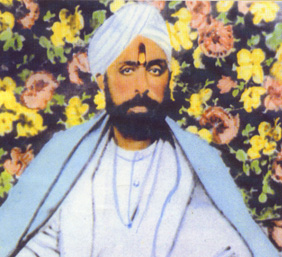
Krishna Joo Razdan

An article in Hindi by Dr. S. S. Toshkhani
- Dr. Shashishekhar Toshkhani
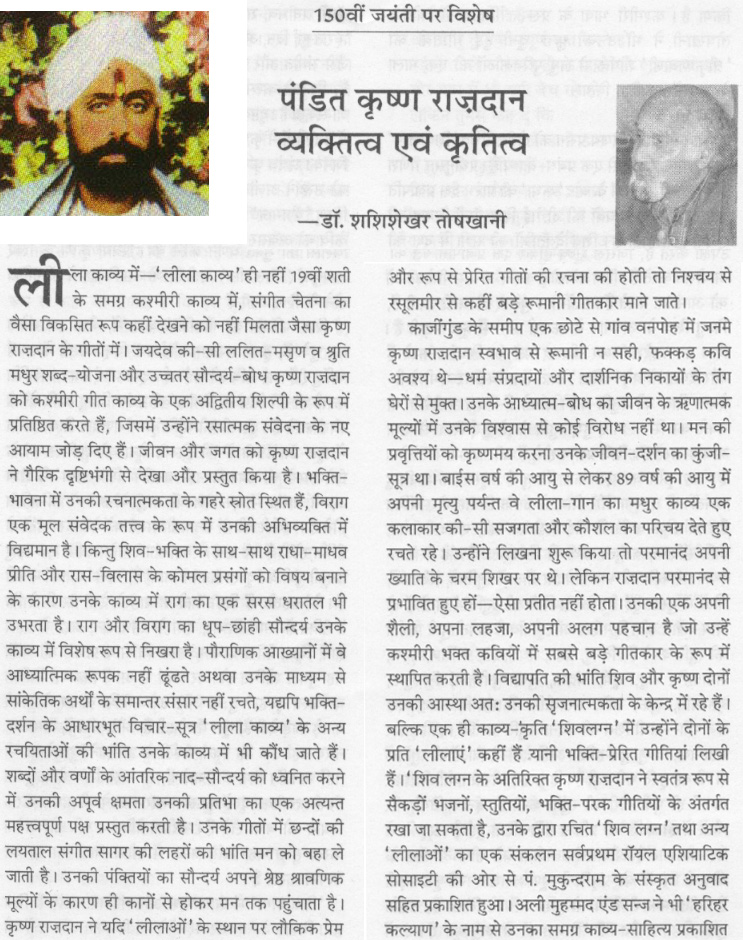
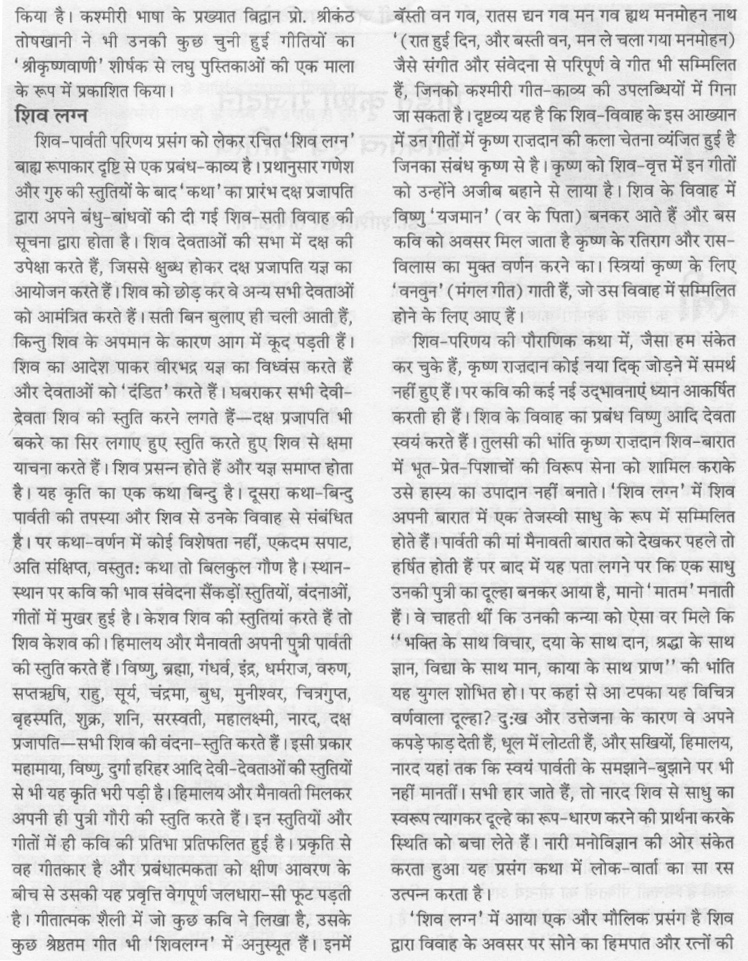
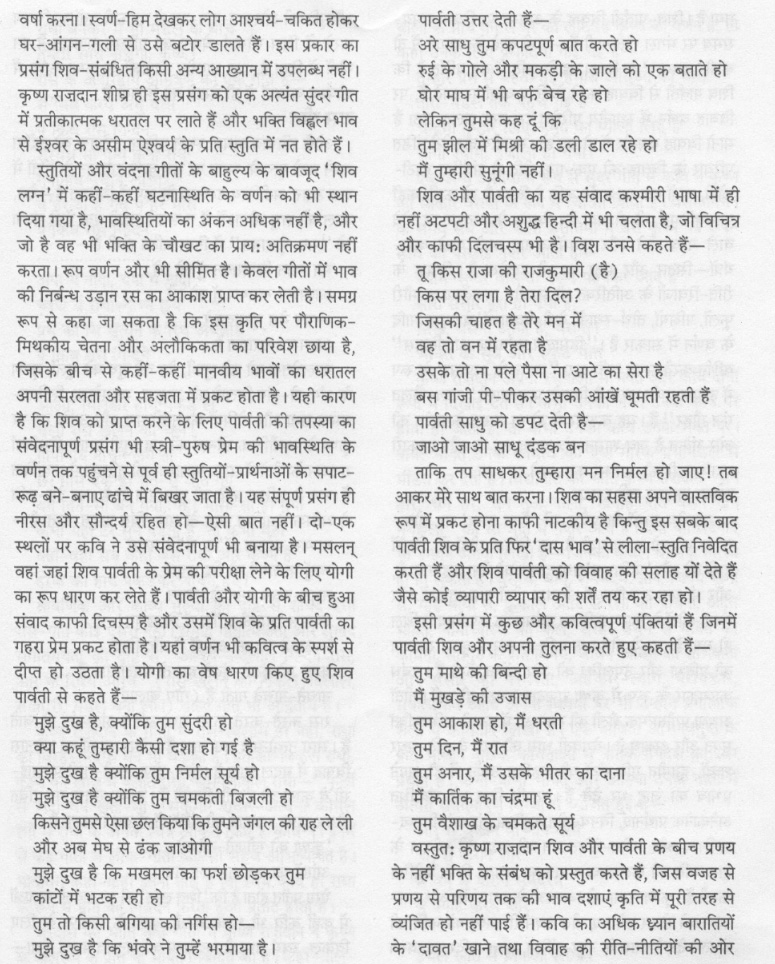
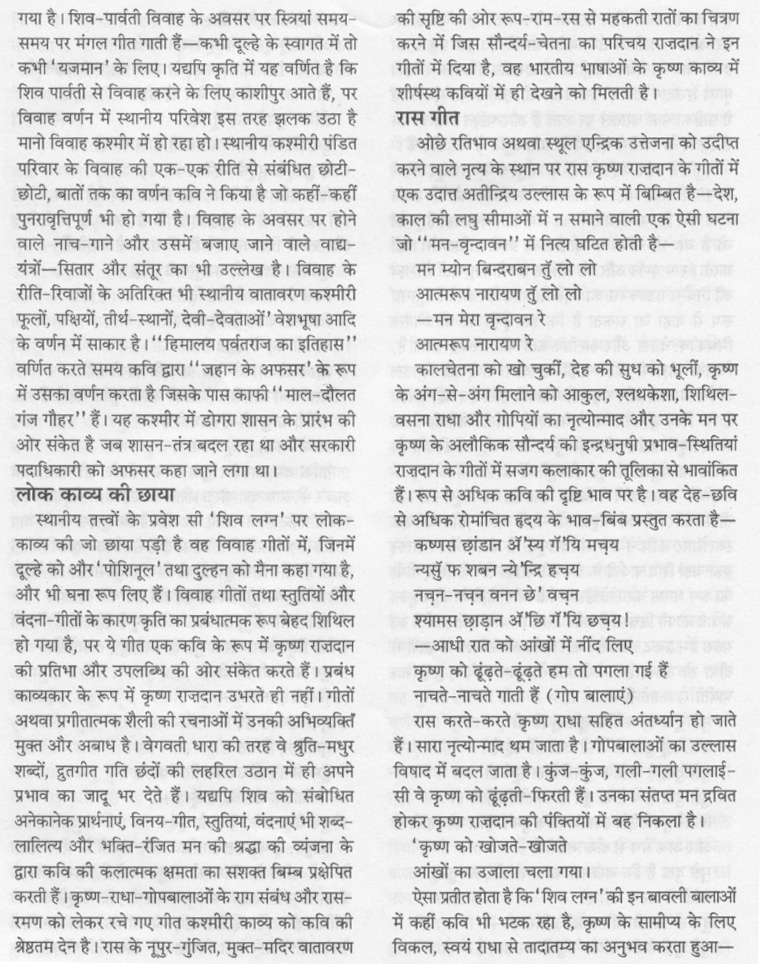
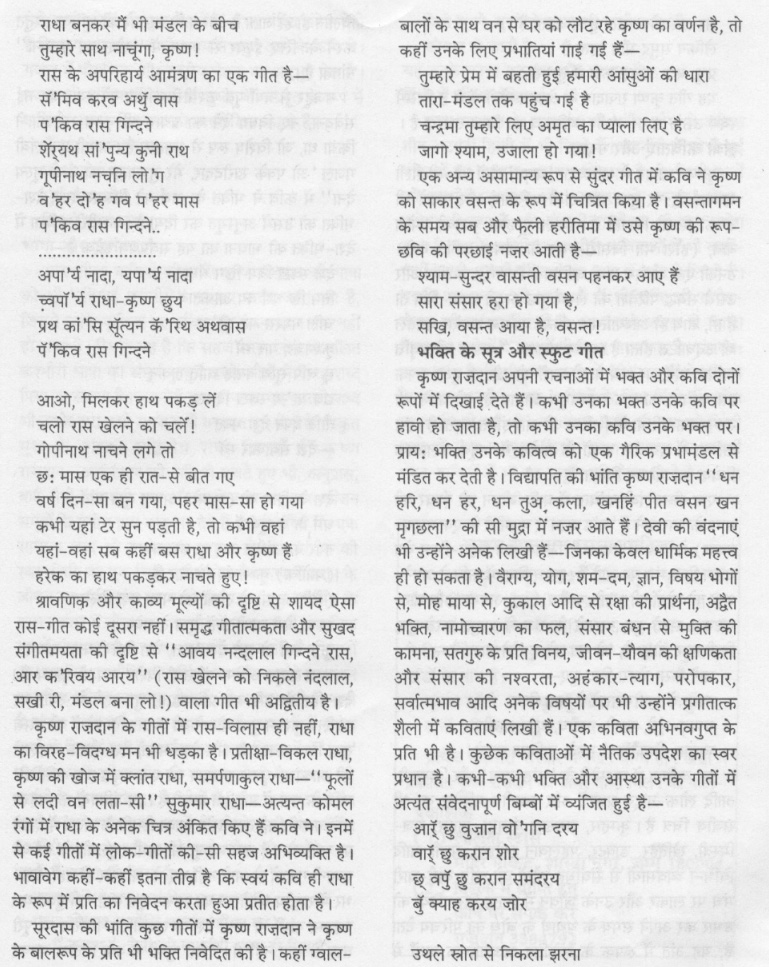
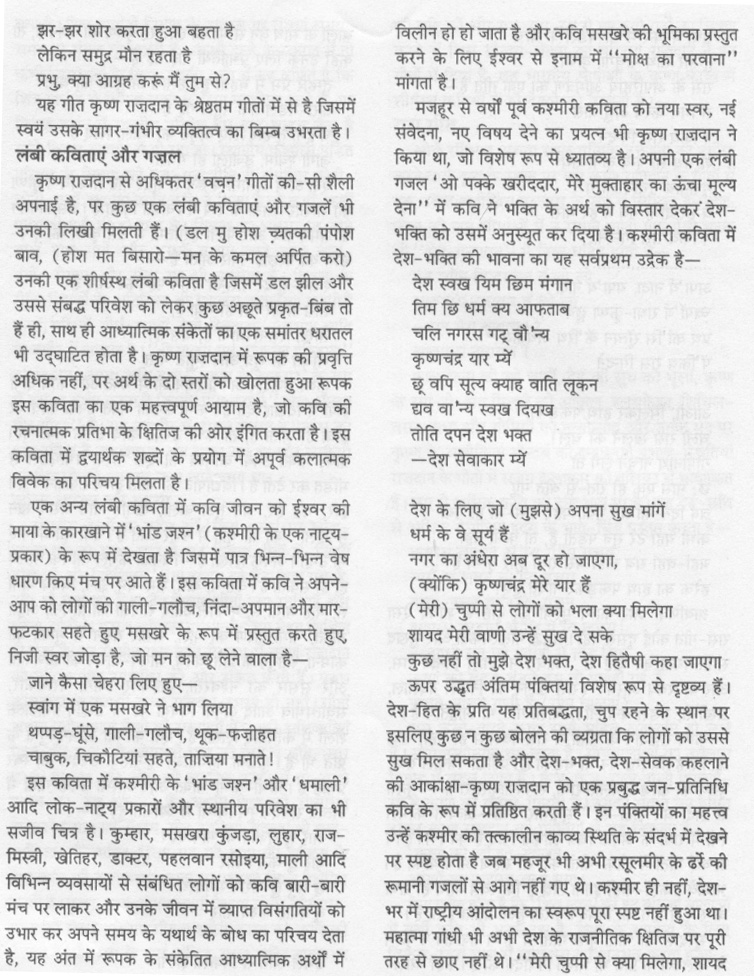

Acche Posh Gav Lachhi Novuy Heth
by Prof. Kanhaya Lal Moza
ACHHE POSH GAV LACHHI NOVUY HETH is a superb devotional lyric in Pt. Krishna Joo Razdan's Shiva Pranae. Here the immortal Kashmiri bard rapturously celebrates Uma's union with Chandrachud. The beautiful flowery metaphors illustrate the saint-poet's deep devotion for Lord Shiva and his Divine Consort, Shakti. The fragrant lyric scintillates numerous flowery hues and tinges. The poetic artifact reveals unique sensitivity of the great devotional poet's visual and olefactory perceptions. Into the flowery fabric Razdan Sahib entwines some eternal idealistic verities. The lyric, as a whole, reflects the unique sancity of Kashmin Hindu wedlock. The predominant mood objectified is devotional repute and ecstasy.
Shiv Pranae is transcreation of Shiva Mahapuran. This devotional literary work opens with the saint-poet's invocation of Lord Ganapati to bless him with the talent for narrating the story of Shiva's union with Shakti. According to the poet, Lord Ganesha, the Onkar-shaped omnipresent god, is the bestower of all kinds of boons. A habitual contemplation of his divine form, dispelling impediments, blesses a devotee with the kinds of successes. Wearing pearly necklaces, he commands Lord Shiva's Rudra legions; he is the vanquisher of Lord Indra and Lord Vishnu, the god with a trunk and a single tusk is the dear son of Shiva and Shakti; he is invited before all gods to bless sacrificial fires, he is the principal attendant of Adi Shakti; the god with four arms, wears red garments and holds his court at Ganpatyar; he carried his four weapons in his four hands for the destruction of demons and maleficent giants.
Pt. Razdan Joo prays to Lord Ganapati to destroy our ignorance with his single tusk which he uses as a stylus and to destroy our'sins and wrath with his axe and other weapons. Lord Ganesha, the infallible dispenser of justice, is worshipped at all holy places before his elder brother, Kumar Kartikeya. This invocation, replete with rich mythological allusions, has been an important item in the devotional repertoire of all Kashmir Hindus for the last several decades.
The invocation of Lord Ganapati is followed by thanksgiving to Sad Guru. For Razdan Sahib, Sad Guru is none other than Lord Shiva himself. He prays for the nectar of bliss and light amidst enveloping gloom. He longs for the realisation of Shiva amidst the trammels of the illusory cosmos. Through the exercise of temperance, he desires liberation from the shackles of lust, wrath, avarice, pride and possessiveness. The practice of evil deeds has obliterated from the poet's vision, co~itenmenl, thoughtfulness, dharma and divine contemplation. He earnesly desires being ranked amongst saints who attained shivahood through intense sadlma.
Pt. Krishna Joo believes that spiritual bliss is realizable through the exercise of Yogic discipline.
He longs for the revelation of the truths enshrined in the Upanishads. He craves for the attainment of Brahmanand. He is conscious of the fact that contemplative concentration is realizable through rigid Yogic discipline through which he seeks divine grace for the purification of his mind and soul. He prays for Lord Shiva's grace in directing his sense perceptions of the eternal truth of Advaita Vedantic monism. The poet is perpetually conscious about the essential divinity of man.
After the invocation of Lord Ganesha and thanks giving to Lord Shiva, the saint-poetnarrates the story of creation as enshrined in Vishnu Puran. According to hirn, Onkar is a symbolic representation of Lord Shiva from whom' illusory cosmos has originated. Cosmic illusion gave birth to Lord Vishnu, Who created Lord Brahma. The entire universe and all life were created by Brahma's will. Brahma created Dakhshiprajapati whom he tutored in all kinds of wordly affairs. DakUshipr.ljapati whom Razdan Sahib calls Brahamrishi, a venerable Taporishi and the king of the gods, begot a large number ot' daughters, one of whom was Uma. The poet considers such a parent, who begets a daughter like Uma, blessed by Lord Shiva Himself. Urna is given away in marriage to ash-besmeared Shiva who is the master of the cosmos. Dakhshiprajapati gives away the remaining 27 daughters in marriage to Chandrama and invites all his relations and friends to participate in these matrimonial festivities.
At this stage of narration, Pt. Razdan Joo ceases to be an omniscient narrator. He sketches lightly the tedium of straight and horizontal narration. His Dakhshiprajapati is a typical Kashmiri Hindu deeply steeped in devotion. He is enjoying a beatific experience because Shiv Nath has become his intimate relation incognito as Dakhshiprajapati. Razdan Sahib feels his being blossoming like a lotus. The mendicant friar, with the Ganga flowing down his hair, has married his daughter. He decides to feed him with boiled rice, butter-milk and sugar-candy. He is convinced that the mystery surrounding Shiva is impenetrable. Shiva's camphor-frame exudes poignant aroma. He is Himself Brahma, Vishnu and the Supreme Being, an ocean of knowledge and the mystery of Onkara. It is through the non-dualist attitude alone that He can be realised. Throughout Shiv Pranae, we observe narrative omniscience beautifully punctuated by dramatized narration.
Pt. Krishna Joo Razdan celebrates the union of Shiva and Shakti in his Achhe Posh Gav Lachhi Novuy Heth. This lyric is one of the most superb achievements in Kashmiri language. Here Shiva is Chandrachud appearing in dark fortnight and Uma is Param Shakti; here Shiva is Lachhinov and Uma is Achhe Posh. With the union of Shiva and Shakti, spring stalks the earth afresh and the cosmos blossoms like a lotus. Here the immortal bard luxuriates in cataloguing flowers. Among the Kashmiri saint-poets, none has made a comparable brilliant use of this technique for the objectification of his devotion. He resorts to a superb metaphorical use of flowers. Uma is Arni Posh and she is carried away by Shiv Ji who is Neov. Like a typical Kashmiri Hindu bridegroom, Shiva is greatly respectful towards Uma's parents. He carries away Uma after seeking the blessings of her parents. Shiva is Gloab; he is Sombul. Uma is Aarwal; she is Yemberzal. Razdan Sahib constantly enjoys the vision of Uma-Rudra. He supplicates before Lord Shiva for a boon of spiritual bliss. In spite of being a master of fabulous treasures, Shiva enjoys being clad sparsely. These persons need no ornaments upon whom the Creator of the universe showers His own bounteous benedictions. Being free from avarice, the material wealth has absolutely no significance for Shiva. He is the creaser of both Brahma and Vishnu.
Razdan Sahib is convinced that spiritual progress is realizable only through regular Yogic exercises. The number of such exercises is very vast but an aspirant needs to practice only a few of them. Achhe Posh Gav Lahhi Novuy Heth is an inspired lyric which cascades forward like the waters of a mountain fill. It exudes the aroma of flowery vernal Kashmir landscape. He imparts superb pictorial touches to the short poetic artifact. The poet's love for Shiva rises to the level of God-intoxication. His Shiv Ji is a cliff supporting the crescent moon, he is vernal Neov; he is Golab, and he is Symbul. For him Uma is Param Shakti, she is an Achhe Posher she is Arni Posher she is Aarwal and she is Yamberzal. All these flowery metaphors conjure up before readers the celestial couple - Lord Shiva and his divine consort Gauri. Lord Shiva is the creator of the cosmos; He is the bestower of respectability; being free from greed and avarice, material riches have absolutely no significance for him. He supplicates before Lord Shiva for spiritual enlightenment, leading to the attainment of salvation. Through a figurative use of Kashmiri, he objectifies his intense love for God.
Just as there are physical phenomena, in the same manner there are mental phenomena. Both these types of phenomena are apodictic realities. It is erroneous to extol one set of phenomena at the cost of the denigration of the other. Rational living consists of a simultaneous recognition of the importance of both these types of phenomena. With the modem man's ever-increasing interest in physical phenomena, we are likely to overlook its importance. This is the tragedy of modem civilization. For rejuvenating our springs of bliss, we will have to cultivate afresh the desire for enjoying it. Just as reading about philosophy can never be a substitute for reading philosophy, in the same manner, reading about philosophy can never be a substitute for reading poetry. Great devotional bards like Pt. Krishn Joo Razdan can be best appreciated only through first-hand experience.
(Prof. Moza teaches English in the Gandhi Memorial College, Bantalab, Jammu.)
An article in Kashmiri by Shyam Lal Razdan
- Shyam Lal Razdan
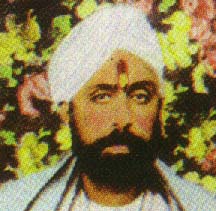



A list of Krishen Joo Razdan's bhajans. A presentation by Prof. Chaman Lal Sapru.
A Presentation by: Prof. Chaman Lal Sapru




